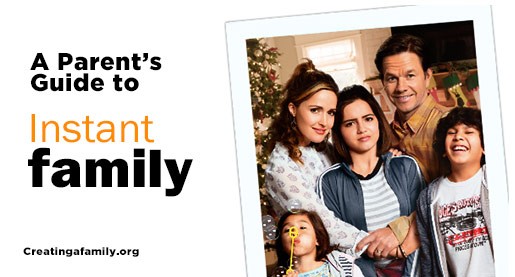The movie Instant Family offers a heartwarming, albeit Hollywood-ized, glimpse into the world of foster care adoption. Having attended a screening and Q&A with director Sean Anders, it’s clear the film strives for authenticity while highlighting the rewarding yet challenging journey of building a family through foster care. This movie isn’t just entertainment; it’s a potential conversation starter for families, especially those considering or already navigating foster care and adoption.
Anders’ personal experiences heavily influenced Instant Family, lending a layer of genuine emotion to the comedic narrative. While the film’s feel-good nature is undeniable, it’s essential to approach it with a thoughtful perspective, particularly when considering viewing it with foster or adopted children. Instant Family can be a valuable tool for families, prompting discussions and offering relatable scenarios, but it’s crucial to be aware of potential triggers and discussion points.
Before delving into potential sensitivities, let’s acknowledge what Instant Family portrays effectively and how these aspects resonate with the realities of foster care adoption. For parents considering this path, understanding these positive portrayals is as crucial as being prepared for the more challenging aspects.
5 Key Takeaways from Instant Family for Prospective Foster and Adoptive Parents
1. The Power of Humor in Coping with Challenges
Mark Wahlberg and Rose Byrne’s on-screen chemistry brings a much-needed lightness to the often-intense realities of foster care adoption. Their characters’ ability to find humor in their missteps and moments of overwhelm is incredibly relatable. Parenting, especially in foster care and adoption, is ripe with unexpected situations and emotional rollercoasters. Humor becomes an invaluable coping mechanism, a way to diffuse tension and reconnect amidst chaos. The film cleverly uses humor not to diminish the seriousness of the situations but to highlight the resilience and adaptability required in parenting. This comedic approach reminds us that laughter can be a powerful tool for navigating stressful moments and building family bonds.
2. The Lifeline of In-Person Support Networks
The foster care support group depicted in Instant Family is a powerful representation of the vital role community plays in the adoption journey. The film showcases the camaraderie, shared experiences, and honest advice exchanged within such groups. These support systems provide a safe space for parents to laugh, cry, vent frustrations, and celebrate milestones together. While online communities like Creating a Family online community offer essential virtual support, the movie emphasizes the irreplaceable value of in-person connections. Building a local support network, whether through formal groups or informal gatherings, is crucial for foster and adoptive parents. These networks provide a much-needed “village” of understanding and encouragement.
3. The Indispensable Role of Honest Case Workers
Octavia Spencer and Tig Notaro’s portrayal of foster care case workers is a standout aspect of Instant Family. They embody the perfect blend of humor and hard truths, delivering crucial information and realistic expectations with both directness and empathy. The film effectively highlights the dedication and emotional labor case workers invest in preparing families, navigating complex situations, and supporting both children and parents through the foster care process. A committed and honest case worker is an invaluable asset, guiding families through the legal and emotional complexities of foster care and adoption. Instant Family underscores the importance of building a strong, trusting relationship with your case worker.
4. Acknowledging the Infertility Journey
Instant Family subtly touches upon the often-overlooked connection between infertility and adoption. The subplot featuring the main characters’ relatives struggling with infertility treatments reflects the reality that a significant portion of adoptive parents turn to adoption after experiencing infertility. The film acknowledges the emotional toll of infertility and portrays the couple’s journey with sensitivity. This inclusion is important as it validates the diverse paths to parenthood and recognizes that adoption is often a conscious and heartfelt choice following other challenges. For many, adoption is not a second choice but a primary path to building their family.
5. Confronting Misconceptions about Foster Care and Adoption
The movie skillfully addresses common misconceptions and societal biases surrounding foster care and adoption. Instant Family doesn’t shy away from portraying the sometimes-ignorant comments and assumptions adoptive families face from extended family and society at large. The film uses humor and direct confrontation to challenge these myths and promote a more informed understanding of foster care and adoption. This aspect of the movie is particularly relevant for adoptive families who often find themselves educating others about the realities of their family building journey. Instant Family encourages open conversations and helps dispel harmful stereotypes.
Navigating Potential Triggers for Foster and Adopted Children
While Instant Family offers valuable insights and positive portrayals, it’s crucial for parents to be aware of potential triggers, especially when considering watching the movie with foster or adopted children. Even well-adjusted children can be sensitive to certain themes and storylines. Parents should consider their child’s age, experiences, and emotional maturity before viewing and be prepared to discuss potentially triggering content. This is not an exhaustive list, but rather key themes that might require parental guidance and conversation.
- Parentification of the Eldest Child: The film portrays the eldest sibling taking on a parental role for her younger siblings, which can be triggering for children who have experienced parentification themselves. This dynamic might resonate with their past experiences and emotions.
- Unresolved Issues with Birth Parents: The movie touches upon the complex relationship with the children’s birth mother, including unresolved conversations and feelings surrounding placement and adoption. This can evoke difficult emotions for children who are processing their own birth family relationships.
- Fear of Re-abandonment: Although Instant Family is ultimately a feel-good movie, the theme of potential re-abandonment by the birth mother, even if subtle, can be sensitive for children who have experienced loss and separation.
- Unrealistic Expectations of Prospective Parents: The film humorously portrays the adoptive parents’ initial “unicorns and rainbows” perspective, which, while funny, might be hurtful or confusing for children who have experienced the realities of parental unpreparedness.
- Honeymoon Period and Subsequent Challenges: The movie depicts the initial honeymoon phase followed by the inevitable challenges and struggles, which can be difficult for children who have experienced similar disruptions in their own placements.
- Boundary Testing by Teenagers: The teenage character’s boundary-testing behaviors, while normal, can be triggering for parents and potentially relatable (and therefore emotionally charged) for teenagers watching the film.
- Trauma-Related Behaviors in Younger Children: The younger children’s trauma-related behaviors, used for comedic effect in the film, can be painful reminders of similar behaviors in the early days of adoption for both parents and children.
- Fear of Temporary vs. Permanent Placement: The movie subtly explores the push-pull dynamic of foster children’s fear of both temporary placements and the permanence of adoption. This resonates with the anxiety many foster children experience regarding stability and trust.
A Valuable Family Movie Night – With Preparation
Instant Family is more than just entertainment; it’s a conversation starter and a potential resource for families touched by foster care and adoption. While not a perfect representation, the film offers relatable scenarios, humorous moments, and genuine emotional depth. However, it’s crucial to approach it with awareness, especially with children.
For families with foster or adopted children, consider pre-screening the movie or waiting for home viewing to allow for pausing and discussion. Prepare to address potential triggers and use the movie as an opportunity to open conversations about adoption, family, and navigating challenges together. Instant Family can be a valuable tool for connection and understanding within your family, fostering empathy and open communication.
Ultimately, Instant Family contributes to raising awareness about the need for loving homes for children in foster care. By highlighting both the joys and challenges of foster care adoption, the movie encourages more people to consider this path to family building.
Are you planning to see Instant Family? How will you use it as a family – as pure entertainment, or as a springboard for deeper conversations?
Image credit: <a href="https://www.instantfamilymovie.com/home/">https://www.instantfamilymovie.com/home/</a>, <a data-rapid_p="37" data-track="attributionNameClick" href="https://www.flickr.com/photos/ocparks/" title="Go to OCParks_CA's photostream">OCParks_CA</a>,<a data-rapid_p="59" data-track="attributionNameClick" href="https://www.flickr.com/photos/youngthing/" title="Go to youngthing's photostream">youngthing</a>
